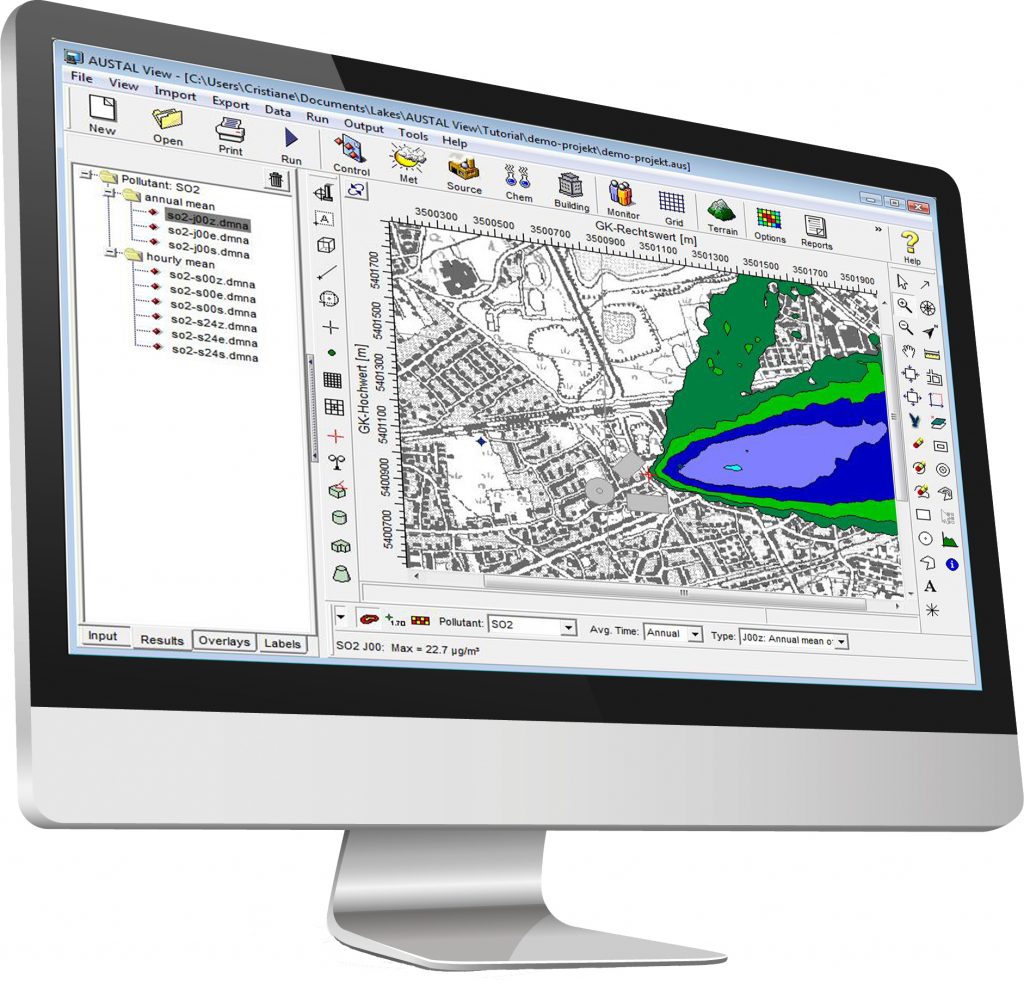
AUSTAL View is a graphical user interface for the official German Federal Environmental Agency air dispersion model, AUSTAL.
The AUSTAL model was developed according to Germany's air pollution control regulation TALuft (Technical Instructions on Air Quality).
AUSTAL is a Lagrangian particle tracking air dispersion model that contains its own diagnostic wind field model (TALdia). The model takes into account the influence of topography on the wind field and therefore on the dispersion of pollutants.
AVAILABLE AUSTAL VIEW MODULES
AUSTAL View is available in three versions (T, G, and TG) and an add-on module. See description below:
- AUSTAL View T: This version supports the TA Luft chemicals but does not support odor modeling (formerly AUSTAL View).
- AUSTAL View G: This version supports odor modeling but does not support the TA Luft chemicals (formerly ODOR View).
- AUSTAL View TG: This version supports all the TA Luft chemicals and odor modeling. This version combines the specialized AUSTAL View T and AUSTAL View G Versions (formerly AUSTAL View G+).
- Multi-Core Module: This module allows for the use of a multi-core (multi-processor) compatible model executables, and allows for the use of up to 8 multi-processors in a single-machine.
Features
Key Features
Integrated Graphical User Interface
Fully integrated interface combining easy to use graphical tools (e.g., sources, buildings, monitor points, and grid), seamless model run, and automated contouring and posting of results.
Powerful 3D Visualization
Complete 3D visualization of your entire modeling area. Sources, buildings, and modeling results are displayed in context with the surrounding terrain. Apply custom textures to buildings to further increase building realism. Create animation file (*.avi) of your 3D visualization.
Export to Google Earth
This exciting feature allows you to export your buildings, sources, receptors and contours into Google Earth giving you a more realistic image of where your pollutants will impact surrounding areas.
Automated Download of Terrain Data(SRTM)
Advanced terrain processing capabilities available for several terrain data formats such as SRTM, USGS DEM, and XYZ.. Automated download of DEM and SRTM files from webGIS. SRTM3 data at 90m resolution is available worldwide. Automated conversion of these formats into the GridASCII data format required by the model.
Support for Several Base Map Formats
Visualizing your site in AUSTAL View is easy. Our full-featured support for a variety of image and base map formats allow you to design your model with confidence and view your results in context with your site. Supported base maps include: Bitmap, DLG, DXF, JPEG, LULC, MrSID, Shapefile, and TIFF/GeoTIFF.
MET Data Visualization Tool - Windrose
Meteo View allows you to create windrose plots for your meteorological data. The following formats are supported: AKT, AKTerm, AKS, series.dmna, zeitreihe.dmna. Options to manipulate the appearance of the windrose are available such as colors, petal size, grid sectors, etc.
MET Data Visualization Tool - Graph
Meteo View, which is included with the package, can also display bar graphs of the wind class and dispersion class frequency distribution and time series graph for wind speed, wind direction, and dispersion class.
German and English Versions Available
The AUSTAL View user interface, help files, and user's guides are available in German and English languages. The AUSTAL model is also available in both languages.
Professional Reports
Clear communication of your modeling and results are crucial to a successful project. AUSTAL View lets you impress with integrated report generation. "Source Parameters", "Monitor Point Results", and "Maximum Calculation Results" are examples of reports automatically generated by AUSTAL View.
Specifications
Technical Specifications
This product is a Microsoft Windows-based program that can be installed in the following Windows operating systems:
- 32-bit and 64-bit Operating Systems
- Windows 10
Minimum Requirements:
- An Intel Pentium 4 processor (or equivalent) or higher
- At least 2 GB of available hard disk space
- 1 GB of RAM (2 GB recommended)
Contact Us

